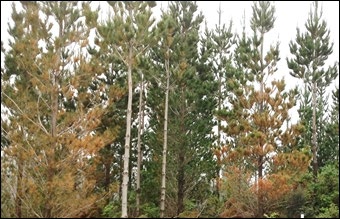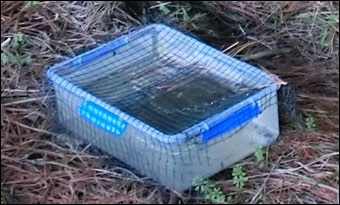PESTS AND DISEASES OF FORESTRY IN NEW ZEALAND
Predicting Red Needle Cast
Scion is the leading provider of forest-related knowledge in New Zealand
Formerly known as the Forest Research Institute, Scion has been a leader in research relating to forest health for over 50 years. The Rotorua-based Crown Research Institute continues to provide science that will protect all forests from damage caused by insect pests, pathogens and weeds. The information presented below arises from these research activities.
From Forest Health News 268, July 2016.
Red needle cast is a relatively recent disease of radiata pine caused by Phytophthora pluvialis. Affected trees do not die, but much of the crown turns an orange-brown colour and growth is temporarily reduced. Scion is conducting research into disease management using two approaches: selection of resistant or tolerant tree stock for new plantings and aerial application of an effective fungicide. Red needle cast outbreaks are unpredictable and vary in different years, seasons and regions. In order to know when to spray, we also need to understand how the disease works. When are the spores produced? At what time does infection occur? How are these factors affected by the environment? What are the conditions regulating the disease? It would also be beneficial if we could predict and limit treatment to years when outbreaks occur.

To address these questions, Scion, in collaboration with forest managers and with the assistance of many Scion and forestry staff, conducted a project to monitor the disease at a number of locations in the North Island and northern South Island. Selected trees were assessed for disease severity at fortnightly intervals for two years. In addition, spore release was followed indirectly over the same period. Traps consisting of leaves and pine needles floating in water were used to determine if Phytophthora was present. This information was analysed together with local virtual daily weather data interpolated from nearby stations provided by the National Institute of Water and Atmospheric Research (NIWA) to see if there were any relationships. At one of the locations some of the trees had been aerially sprayed with phosphite fungicide in an experimental attempt to control the disease. As a further study, some of the bait traps were placed beneath fungicide treated trees in order to see if the production and release of spores might have been reduced.

The key finding from this work was that although Phytophthora spores were produced during much of the year, there was a greater chance of detecting them in the bait traps during cooler temperatures and after days of higher rainfall. Moisture from rain, dew or fog is required for spore germination on needle surfaces and the colder months of autumn and winter were found
to be the preferred period. Phytophthora pluvialis was detected more frequently in the traps than P. kernoviae, another species sometimes found infecting radiata pine needles. No trends were revealed from the monitoring of crown symptoms in selected trees, but the information obtained will be useful as complementary data in a new project attempting to relate disease to weather. Disease outbreaks at particular locations have been observed to recur at intervals exceeding the two year span of the present study. The experimental spray application failed to control the disease, for a number of reasons, so it was not surprising that there was no decline in the detection of the Phytophthora species in traps placed beneath sprayed trees.
This project has been valuable in recognising and confirming the significance of cooler temperatures and rainfall in contributing to disease development. It is now necessary to refine the work by quantifying more precisely the parameters under which infection occurs, for instance by conducting inoculation experiments under a range of controlled environmental conditions.
Nari Williams and Ian Hood (Scion)
This information is intended for general interest only. It is not intended to be a substitute for specific specialist advice on any matter and should not be relied on for that purpose. Scion will not be liable for any direct, indirect, incidental, special, consequential or exemplary damages, loss of profits, or any other intangible losses that result from using the information provided on this site.
(Scion is the trading name of the New Zealand Forest Research Institute Limited.)

 Farm Forestry New Zealand
Farm Forestry New Zealand

